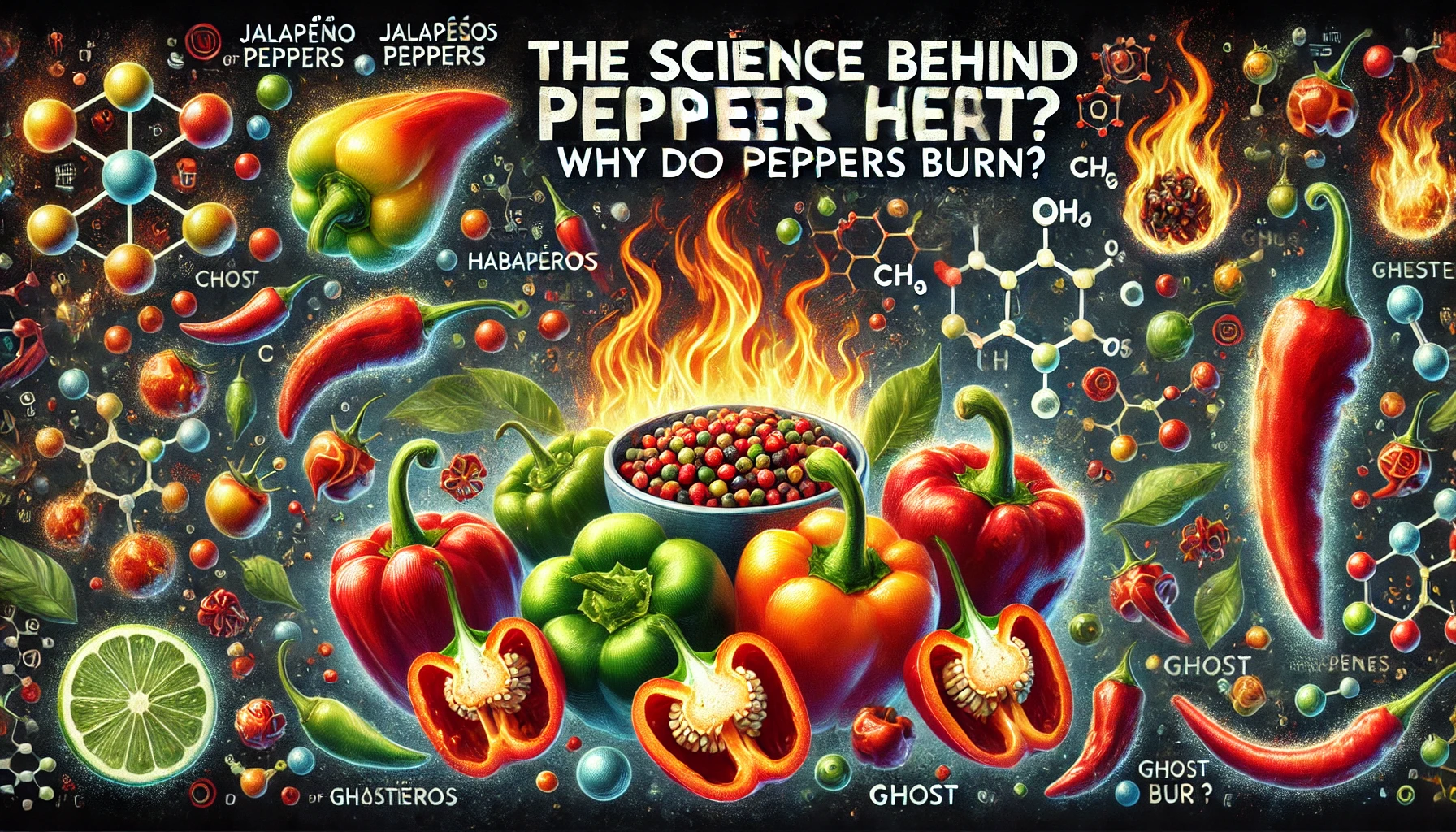Peppers, with their vibrant colors and distinct flavors, add excitement and complexity to countless dishes worldwide. But for many, it’s the heat of the pepper that truly makes it stand out. This burning sensation can range from a mild tingle to an intense blaze that brings tears to your eyes. But what causes this heat? Let’s dive into the science behind why peppers burn.
The Culprit: Capsaicin
The primary compound responsible for the heat in peppers is capsaicin. This naturally occurring chemical is found in the fruits of plants from the genus Capsicum, which includes bell peppers, jalapeños, and the infamous Carolina Reaper.
Capsaicin is part of a group of compounds known as capsaicinoids. These compounds bind to pain receptors in the mouth and throat, specifically the TRPV1 receptors. These receptors are usually responsible for sensing heat and physical abrasion, so when capsaicin binds to them, your brain perceives it as a burning sensation.
Why Do Peppers Produce Capsaicin?
The production of capsaicin in peppers is a defense mechanism. Capsaicin deters mammals from eating the peppers because the burning sensation is unpleasant. However, birds, which are major seed dispersers for pepper plants, are unaffected by capsaicin. This selective deterrence helps the plants spread their seeds effectively without being consumed by mammals.
Measuring the Heat: The Scoville Scale
The heat of peppers is measured using the Scoville Heat Scale, developed by Wilbur Scoville in 1912. The scale measures the concentration of capsaicinoids in Scoville Heat Units (SHU). For example, a bell pepper has 0 SHU, a jalapeño ranges from 2,500 to 8,000 SHU, and a Carolina Reaper can exceed 2,000,000 SHU.
Originally, the Scoville test was subjective and involved human tasters. Today, more accurate methods like High-Performance Liquid Chromatography (HPLC) are used to measure capsaicinoid content.
The Reaction in Your Body
When you bite into a spicy pepper, the capsaicin binds to the TRPV1 receptors in your mouth. This sends a signal to your brain that you’re experiencing heat. Your body reacts by trying to cool down, often causing you to sweat, turn red, and produce more saliva.
In addition to the mouth, capsaicin can affect other parts of your body. If you touch your eyes after handling peppers, you’ll experience a burning sensation because the TRPV1 receptors in your eyes are similarly activated. Always wash your hands thoroughly after handling hot peppers!
The Benefits of Capsaicin
Despite the burn, capsaicin has several health benefits:
- Pain Relief: Capsaicin is used in topical creams to relieve pain from conditions like arthritis and neuropathy. It works by desensitizing the TRPV1 receptors, reducing the perception of pain over time.
- Weight Loss: Capsaicin can boost metabolism and increase fat oxidation, making it a popular ingredient in weight loss supplements.
- Cardiovascular Health: Some studies suggest that capsaicin can help reduce blood pressure and improve heart health by promoting better blood flow.
- Cancer Prevention: Early research indicates that capsaicin may have anti-cancer properties, potentially inhibiting the growth of cancer cells.
Why Some People Love the Burn
The experience of eating spicy food can be addictive for some people. This is partly due to the release of endorphins, the body’s natural painkillers, which create a sense of euphoria and well-being. Additionally, some people enjoy the challenge and thrill of handling high levels of heat.
Tips for Managing the Heat
If you find yourself overwhelmed by the heat of a pepper, here are some tips to help manage the burn:
- Dairy: Milk, yogurt, and other dairy products contain casein, a protein that can help break down capsaicin and soothe the burning sensation.
- Starch: Bread, rice, or other starchy foods can help absorb the capsaicin oil and provide relief.
- Acidic Foods: Lemon or lime juice can help neutralize the alkaline nature of capsaicin.
- Avoid Water: Drinking water can spread the capsaicin oil around your mouth, potentially making the burning sensation worse.
The Hottest Peppers in the World
For those who seek out the spiciest experiences, here are some of the hottest peppers known to date:
- Carolina Reaper: Currently holds the Guinness World Record as the hottest pepper, with an average of 1,641,183 SHU and peaks at over 2,200,000 SHU.
- Trinidad Moruga Scorpion: With a heat level of around 2,000,000 SHU, this pepper is not for the faint-hearted.
- 7 Pot Douglah: Known for its chocolate-brown color and intense heat, it ranges between 923,000 to 1,853,936 SHU.
- Bhut Jolokia (Ghost Pepper): Once held the title of the world’s hottest pepper, it measures around 1,000,000 SHU.
Conclusion
The heat of peppers is a fascinating blend of biology and chemistry, rooted in a plant’s natural defense mechanisms and measured by the Scoville scale. Capsaicin, the chemical responsible for the burn, activates pain receptors in our bodies, leading to a range of reactions from sweating to the release of endorphins. Despite the discomfort, many people enjoy the heat for its unique flavor and health benefits. Whether you’re a spice enthusiast or just curious about the science, understanding why peppers burn can add a new level of appreciation to your culinary adventures.
- Capsaicin, Why do peppers burn, Pepper heat explained, Science of pepper heat, Capsaicin effects, TRPV1 receptors, Why do peppers feel hot, Heat in peppers, Pepper burn relief, Why do peppers cause burning, Scoville units, Hot peppers and capsaicin, Why do peppers burn your mouth, Spicy food science, How to reduce pepper heat, Capsaicinoids ,Spicy food addiction, How capsaicin works




Pingback: Top 10 Spiciest Peppers in the World - Backyard Botanist
Pingback: The Scoville Scale Explained: Measuring Pepper Heat - Backyard Botanist